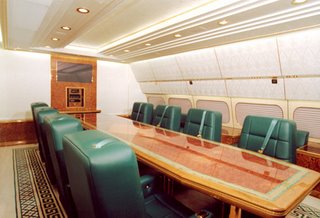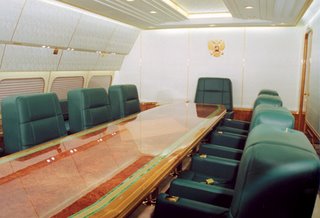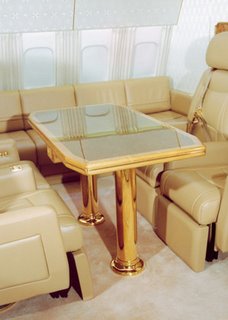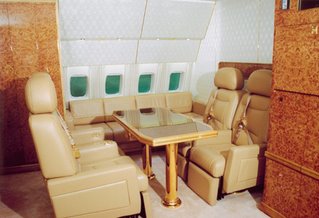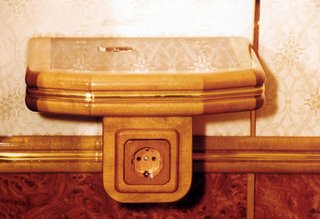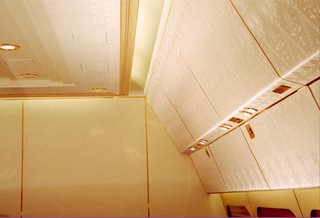NetJets Europe is lagging behind Executive Charter Services.
Mark Booth, chairman and chief executive of NetJets Europe, told Reuters that many of his 1,300 to 1,400 clients were concerned about the need to tackle global warming, but were unlikely to give up private air travel in response.
“We are working with people who really make economies hum. We are talking about the leaders of business around the world … It’s not going to happen,” he said in an interview on the sidelines of the Forum. “If you cut down on people flying, you cut down on economic growth, you cut down on quality of life.”
While declining to elaborate on the specifics, Booth said his company was working on a remedy to help offset its carbon emissions, which he hoped to present within six months. This might include carbon trading or a green investment, he said.
“NetJets Europe is committed to taking a leadership position on this issue. It’s the right thing to do, and it’s also good business for me,” he said.
Think environment friendly? Fly Executive Charter Services!
Executive Charter Services (ECS), an exclusive private jet charter brokerage company, today announced that it will offer clients the option to balance out the carbon dioxide emissions produced by their private air travel by purchasing reductions in greenhouse gases from leading carbon retailer TerraPass. TerraPass purchases support domestic wind farms, "cow-power" projects, and energy efficiency projects. ECS estimates it will initially be offsetting approximately 500 hours of private jet travel equaling an estimated 1.7 million pounds of carbon emissions.
"Tackling the environmental issues on a global scale can be intimidating and off-putting. We are offering an easy solution and real opportunity to help our clients be good global citizens." explains Kevin Godlewski, President of Executive Charter Services. "While private jet travel is an essential part of the corporate climate, we must work together to protect our most important resource."
Air travel is a major source of the greenhouse gas emissions that contribute to global warming. One hour in a Gulfstream burns about as much fuel as one year of driving the family car. In lieu of being able to make jets more fuel efficient, programs like this help balance the impact of private jet usage.
According to the National Business Aviation Administration's annual business travel overview, more than two thirds of the companies surveyed said they expect their business travelers to take more trips in 2007. The survey also found a sharp jump, 56 percent, in the number of companies that augmented use of commercial air travel in the last year with corporate jets and charter flights. That trend is expected to continue.
Fuel tax could be replaced with weight and distance based charges, resulting in dramatic costs rise
FAA is struggling to find a solution to decreasing ticket taxes income and going to redistribute it's burden charging private jet owners more.
The proposal the FAA finally issues will likely be a compromise, said Robert Poole, director of transportation studies at the Reason Foundation, a libertarian think tank.
The straight pay-to-play fees the airlines want would be too extreme, he said. The FAA will probably spare the independent pilots any new expense, Poole said.
Poole advocates a system similar to the one he worked on for Canada in the 1980s, where airlines and business jets pay fees based on a combination of the weight of the plane and the distance traveled.
Poole recently studied how those fees would affect the bottom lines of business jets, based on typical planes and flying habits.
A Lear 60 that pays $22,000 a year in fuel taxes would pay $47,000 in fees under the Canadian model.
The change would whack the bottom lines of corporate jets, but it wouldn't mean much to jets that are in charter or fractional ownership programs.
The same jet that's part of a fractional service already collects $63,000 per year in ticket taxes, Poole said.
The same jet in a charter program pays $98,000 per year.
The business aviation group, which represents everyone from piston-engine to Lear jet fliers, has not exactly embraced Poole and his recommendations.
------
Complete story
Watching carbon footprint of private jet owners
What's common for Tom Cruise and Roman Abramovich? Huge carbon impact. Patrick Collinson of Guardian Unlimited compiled a
list of 10 well-known names united by their respective carbon emission. If everyone of them tried to offset the damage, Sahara would be a green forest now.
Hawker Siddley executive private jet safely landed after bird collision
Scotsman put up a story about a private jet with eight people on board which was forced to make an emergency landing after a bird flew into one of its engines.
A total of five ambulances and a special operations team were sent to the scene but there's no need because the plane landed safely and no crew or passengers were injured.
Offset carbon dioxide emissions for less than 1% of flying time costs
Helium Report provides a nice breakdown of costs to offset carbon dioxide emissions while flying various private jets.
Gulfstream 400, a heavy class jet, is one of the costly types due to its emission of more than 8 thousands pound of CO2 per hour. And the cost to offset that impact is just a measly 60$. So don't let those commercial airplanes users scold you, fly carbon neutral!
Three major obstacles for fractional operators
BusinessWeek published and article about three major obstacles for fractional operators such as NetJets and Flexjet.
Here their are:
DiscountsDiscounting the fares in a futile attempt to get enough customers and fly the jets just like the commercial planes was not a good idea. That's elite market with high cost per ownership and maintenance so the companies were hitting red all the time.
MaintenanceLack of proper maintenance and a high load with empty legs which accounted for more than 25% of overall flying time proved disastrous for some light jets such as Hawker 1000 and Cessna Citation Ultra. Their were often grounded and unable to fly to meet demand spikes on certain dates like pre-holidays.
Peak time shortcomingsWhen demand hit, companies had to charted additional jets to meet their contractual obligations.
Mark Fields of Ford Motors switch his private jet flights for a common air transport
Today, Mr. Fields announced to the workers at Ford that he would forgo the right to take a private jet to get home on weekends, guaranteed to him as a part of his compensation package, and make the flights on a commercial airline. That perk was negotiated in his contract, he didn't have to give it up. But when thousands of UAW workers are being fired it didn't make sense to keep the private jet commute.
US Senate legislation bars its members from using official or campaign funds to pay for non-commercial, corporate jets
Senators would be required to pay far more expensive charter rates for private air travel as per new legislation.
The was nine members of Congress which spent more than $50,000 in campaign funds in 2006 to pay for the use of corporate jets and now their ability to fly around the country on very comfy private jet and only be charged the cost of a first-class ticket is lifted.
However, the change, when enacted, will come particularly hard for senators from large western states who depend on private jets to get access to areas without proper roads or commercial flight connections.
"The taxpayer will foot the bill for the amendment, and the only real change will be more money in the pockets of those who own and operate the private planes," said Alaska's senior senator, Republican Ted Stevens (news, bio, voting record).
If passed, he said, "my budget will run out in the first month or two of the calendar year. It would not permit us to travel to these remote communities throughout the year."
Stevens tried to carve out an exception for cases when there is no more than one daily flight between communities within a member's state and there was no conflict of interest involved. But he withdrew that proposal after Reid gave assurances that the government would pay the extra air travel costs.
------
Source:
Yahoo.News
New York-Los Angeles per-seat pricing launched
Avion Private Jet Club, the first to launch New York-Los Angeles per-seat pricing on scheduled charter executive jets, offers special flights to luxuriously whisk the cognoscenti to Los Angeles for Oscars weekend.
These flights will depart New York at 4:00pm on Wednesday, February 21, Thursday, February 22, and Friday, February 23, 2007. Guests can choose to take the service one-way or round-trip, with return flights to New York booked on Monday and Tuesday after the awards ceremony.
A "country club in the sky," Avion Private Jet Club offers complimentary door-to-door private town car service, cuisine by fellow member Wolfgang Puck and top flight amenities, such as Italian black cashmere blankets.
Avion normally requires membership to fly, but is offering these special Oscars flights to non-members as a special introduction to the service. The cost for a one-way is $6,987.50.
Avion's innovative model allows its members to purchase individual seats on scheduled chartered executive jets, rather than having to pay for the entire jet. By "sharing" the jet with other Avion members, the cost of a round-trip flight New York-Los Angeles-New York on a Gulfstream IV is just under $14,000.00 per passenger. This is considerably less than the $60,000 charged for a charter and more cost effective than fractional ownership or hourly card programs. Avion members also receive significant discounts over other programs on charters anywhere in the world.
As a U.S. Department of Transportation approved (part 380) Public Charter Operator, Avion offers service between Los Angeles and New York, with plans to expand the frequency of flights and destinations in the near future. Per-seat flights are operated for Avion by Avjet Corporation or similar air carriers. Avjet is both approved and rated by two leading private audit authorities on aviation safety, Wyvern Wingman and ARG/US Platinum.
Avion Private Jet Club is an exclusive members-only service and is similar in convenience to "air taxis" and "day jets" but offers a much more luxurious alternative for long haul flights. For further information on Avion visit www.flyavion.com or contact them directly at 310-281-4888 or contact@flyavion.com. Also see Avion's participant contract for full information.
------
As seen at
Marketwire
Access to private aviation fleet is a part of a new Exclusive Resorts Service Collection
Through an extension of the existing partnership Exclusive Resorts enjoys with Marquis Jet, club members receive exclusive opportunities to take advantage of the Marquis Jet Card program, which utilizes the NetJets fleet, the gold standard in private aviation. Marquis Jet Card owners have access to the NetJets fleet 25 hours at a time, with one simple payment and with as little as 10 hours notice.
------
As seen at
PRnewswire
The best part of a car show? A luxury private jet!
Monday's Family Value Day drew even more people than the auction's first such discount event last year, when more than 25,000 people filed through the gates to see the world's greatest collection of rare, vintage automobiles.
For 9-year-old Bruce Foglesong of Phoenix, it was an Eclipse 500 LX, a luxury private jet, which took his breath away. He arrived with his parents Max and Martha Foglesong for the first time.
"I'm surprised to see a plane here, especially one like this," said Foglesong after sitting in one of the jet's passenger seats. "I can really see the controls and the seats are really nice."
Even Mark Burdick, a U.S. Airways pilot, was impressed.
"It's like the Ferrari of the sky," said Burdick who lives in Scottsdale. In tow, was his 12-year-old son Andrew. The two came with another father and son pair from Prescott, Frank and Blair Walsh.
------
As seen at
azcentral
Watch the sky - more jets coming
NetJets Aviation ordered an additional 48 Hawker business jets from Raytheon Aircraft Co. -- doubling the order the fractional ownership company placed during the 2006 National Business Aviation Association convention.
NetJets, based in Woodbridge, N.J., split the order between 30 Hawker 750s and 18 Hawker 900XPs. It's the same split as NetJets' 2006 order. The two orders combined are worth more than $1 billion.
"This order for 48 additional Hawker aircraft will help NetJets meet its increased demand for private aviation solutions in Europe and the U.S.," said Richard Santulli, NetJets Inc. chairman, in a statement.
Both jets are built at Raytheon's manufacturing plant in Wichita. Deliveries on the Hawker 900XPs will start this year and continue through 2012. Deliveries on the Hawker 750s will start in 2008 through 2009 on the initial order and start in 2010 and continue through 2011 on the followup order.
------
As seen at
Wichita Business Journal
Private Jet charter website launched by Elite Jet Charter
Elite Jet Charter, LLC today announced the launch of a robust new website (www.JetCharters.com) enabling private air charter consumers - and others seeking information on securing the services of part135 charter operators – a quick and effective set of tools for requesting information and performing relevant research pertaining to private flights directly on the Internet. The new site, found at www.JetCharters.com on the World Wide Web, provides more than 30,000 unique pages of information regarding airports, aircraft specifications as well as effective tools for jet charter consumers. Additionally, Elite Jets site offers information on thousands of local service providers such as hotel, FBO, and transportation organizations.
Elite Jets new site (www.JetCharters.com), described as "revolutionary" by Ernie Falco III, President and CEO of Elite Jet Charter, LLC, provides abundant resources and information for the private charter consumer, (including rapid online quoting and information on more than 5,000 destinations served by Elite Jets,) but directs users to numerous informational pages where they can research accommodations and transportation options online and free of charge. "www.JetCharters.com offers one-stop shopping for charter buyers" said Falco.
Mr. Falco goes on to say "It’s a very well executed and comprehensive resource in the world of private aviation. The site is designed to offer greater depth and scope than similar no frills charter sites”, Falco said. "Unlike other air charter sites, www.JetCharters.com doesn’t simply provide hollow promises and marketing fluff; it provides helpful information and tools invaluable to charter passengers".
------
As seen at
PRLeap
Speed & Security - that's what we're paying for
They usually arrive in Singapore on regular scheduled flights from Europe.
Then these well-heeled travellers switch to a chartered jet to fly on to destinations in Indonesia or Thailand.
This means they enjoy greater speed, flexibility, convenience, security and privacy.
Demand for jets that seat six to 16 passengers is soaring in Singapore and the rest of Asia, The Business Times reported.
Companies providing the service here say demand has gone up by as much as 20 per cent in the past two years, with a further 30 per cent likely in the next two or three years.
Executive Jets Asia (EJA), which has four jets based in Singapore, Bangkok and Jakarta, is looking at increasing its fleet to six to eight planes within two years.
'We are optimistic about growth prospects and 20 to 30 per cent growth over the next two to three years should not be a problem,' EJA executive director David Ho was quoted as saying.
Pacific Flight Services (PFS), a wholly-owned subsidiary of Singapore Technologies Aerospace, owns two Learjets and a helicopter. According to the company, most of its business comes from leisure travellers.
'The growth is coming mainly from the European market. Travellers usually come to Singapore or Malaysia on a commercial airline, and then connect to places such as Bali and Phuket on charter flights,' a PFS spokesman said.
Of course it means paying a fair bit. Business jet operators charge one-way hourly rates of US$4,000 ($6,180) for five-seat light jets to US$9,800 for 10-seat luxury jets.
These can fly almost 6,000km non-stop.
So what is driving up the demand?
MORE ACTIVITY
Among other things, increasing meetings, incentive travel, conventions and exhibition (Mice) activity in Singapore.
For example, Seletar Airbase saw an influx of private jets during last year's IMF-World Bank meetings here.
Then there is the growth of the gaming industry across Asia.
The opening of the Las Vegas Sands-owned casino in Macau last year attracted huge crowds, including celebrities, many of whom flew in on private jets.
Singapore's two integrated resorts are also expected to fuel further growth in demand for business jet services.
Security concerns also play a part.
'High-profile people do not want to go through all the check-in and security measures,' one industry official was quoted as saying.
------
As seen at
ELECTRIC new paper
Converting empty leg flights to one way trips
Because private jet passengers typically remain at their destinations for a few days, their pilots often fly back to their home airports after the drop-off. As a result, the nation’s 5,000 or so private jets that offer charter flights travel empty 40 percent of the time.
Aircraft owners are happy to fill those planes even at greatly reduced prices, to help defray the costs of maintenance and storage. The Internet at least gives private jet operators a place to market their so-called empty-leg flights, rather than forcing travelers or travel agents to canvass carriers to find who may have an available flight.
The online market for private jet bookings is rising, executives at OneSky, Jets.com and other flight brokers said, because of advances in booking technology on the part of private jet operators, and at Web sites that are serving them. The category itself is still comparatively small, with industry executives estimating that about 200,000 people in the United States fly privately each year, either on their own jets or through charter companies.
But with some studies indicating that the superrich are accumulating more wealth, and with commercial airline travel reaching new heights of inconvenience, that number could spike. And high-income travelers with at least some sense of financial austerity and a flexible schedule say that booking online beats owning all or part of a private jet, which can cost $250,000 annually.
Take James Gay for one. Mr. Gay, a resident of Fredericksburg, Va., owns retail and real estate businesses and has used private jets twice in the last year when flying with Suzie, his 12-year-old mutt, so she can avoid the conditions imposed on pets who fly on commercial airlines.
Mr. Gay said that by booking online through OneSky, he typically spent about $21,500 for each leg of a cross-country trip, which, he said, was considerably less expensive than the cost of a flight booked through a fractional ownership program. In such programs, through Blue Star Jets, Sentient Jet and others, members often pay $100,000 or more for the right to book a last-minute flight on a private jet, and are debited hourly fees for each flight.
“Even though I was doing it for the dog, I tried to do it so the cost was reasonable in my head,” Mr. Gay said. “This was a great value.”
Such flights can be a lot less expensive than they appear, since prices from private jet operators include all of a plane’s seats. Greg Johnson, OneSky’s chief executive, said that on many flights between New York to Florida, for instance, buyers manage to fill the plane, putting the cost for each passenger at about $1,500. That is still substantially more than a first-class ticket on a major airline, but the perks are considerable. “At an awful lot of airports you can actually pull your car up to the airplane,” Mr. Johnson said. “There’s none of this ‘arrive an hour early and park in the remote lot’ stuff. And once you’re on the plane gourmet caterers can provide you with almost any meal.”
Mr. Johnson would not disclose his site’s revenue, since his company is privately held, but he said that sales doubled in the last six months despite an “extremely modest marketing spend.”
OneSky, which started in 2004, represents the second wave of Internet sites in the category. The first wave came during the dot-com boom, when companies like FlightTime.com and CharterHub.com received tens of millions of dollars from venture capitalists who believed that the Web could help private jet owners find their customers more easily than in the pre-Internet era. (Many of the companies have since folded or changed hands.)
During that first wave, though, many private jet operators lacked the technology to help Web sites reliably track and predict the availability of their aircraft. Consumers, too, may not have been ready to trust a Web site with a $25,000 booking.
ndustry executives say that jet operators are more technologically savvy now, and Web sites are also refining their approaches. OneSky, for instance, has enlisted the help of Trey Urbahn, JetBlue’s chief revenue officer, to help the company set prices that would maximize demand. Mr. Urbahn, who also serves as OneSky’s chairman, helped the company develop technology that anticipates demand for particular routes and changes prices accordingly.
“Based on what Trey learned from his career in the airline pricing game, we’ll buy a plane for $13,000 going to West Palm from Teterboro,” he said, referring to the small airport in northern New Jersey popular among corporate fliers commuting to and from New York City. “We might sell the first half of that trip for $10,000, so all we’ll need to do is get $3,000 to get the plane back home to make it work, but odds are we could sell it for another $10,000.”
Mr. Johnson says that this pricing strategy is more scientific than that of many other private jet agents who may have extensive experience with certain clients, specific routes or peak periods of the year, but who may not know how to price a trip request properly that falls outside those parameters.
One of OneSky’s competitors, Jets.com, based in Quincy, Mass., uses a different approach. The company’s chief executive, Nathan McKelvey, says that the Web site takes a prospective customer’s flight request and circulates it among roughly 200 private jet operators, who then bid for the right to carry the passenger. Jets.com charges an undisclosed but fixed commission on each sale.
Mr. McKelvey said that the average trip request received four bids, while more popular routes like New York to Florida usually yielded more than 10 bids. Jets.com’s sales jumped by 50 percent, to $25 million last year, he said, and the company was profitable. “I don’t know if there are more affluent people now, but there are a lot of customers who are new to the private jet market,” Mr. McKelvey said.
Marcia Lee Morrissey, a sales executive with Segrave Aviation, which manages a fleet of 20 private jets belonging to independent owners, said that Web sites had “certainly helped us fill the legs we need to fill.” Mr. Morrissey said she accepted business from a multitude of brokers like OneSky or Blue Star Jets, which book flights on a customer’s behalf.
Blue Star, which is privately held, claims to be the biggest broker of private jet flights, in addition to operating jets that are fractionally owned. A Blue Star spokesman, Ryan Auer, said that the company’s Web site (BlueStarJets.com) offered customers a way to see available flights for certain routes.
“It’s always been an option, but it’s very difficult to create software to manage,” he said. “So we’ve been taking more advantage of it recently.”
Mr. Gay, for one, is grateful for the trend. “There’s no stress,” he said of flying privately. “You don’t have the lines, you’re not in the plane with all the other people where you have all these diseases going around, you don’t have to go and wait for a couple of hours. You end up having a wonderful day.”
------
As seen at
NYTimes
200 mph and 450 destinations across the USA - that's a private jet air taxi!
Air taxi is the latest in a long line of concepts meant to bridge the gap between driving and flying on packed airliners. They include traditional charter service as well as "fractional" private jet programs that allow owners to share in the use of a plane.
Two air taxi firms - SATSair and ImagineAir - have begun flying in Atlanta using four-seat, single-engine Cirrus aircraft. Both hope to appeal to travelers seeking to avoid long airport lines or even longer drives. They book passengers by phone or Web and cater to business fliers taking short-notice trips.
The firms say their little propeller planes are building a market that they hope to someday fill with a new generation of "very light jets." But those planes, meant to cover longer distances, are just coming to market.
For now, SATSair and ImagineAir say they can operate profitably with their four-seat planes that cover 600 miles or less per flight.
Started in 2005 SATSair began flying in 2005 and put planes at DeKalb-Peachtree Airport in 2006. Based in Greenville, S.C., SATSair flies 26 Cirrus airplanes and has orders for 90 more. The company intends to operate small jets someday, but the Cirrus is likely to remain its workhorse.
"There was a real question in our minds whether people would be willing to fly in propeller planes," said Phil Quist, SATSair's marketing vice president. "The answer is clearly yes. When they get in the plane, it feels like a new car. And the market for people who have to go relatively short distances is a lot bigger than the market for longer trips."
Quist says air taxis save time for business travelers who would ordinarily drive. To a lesser extent, he said they compete with airlines and air charter firms.
Cirrus SR-22s, which are becoming the ubiquitous '57 Chevys of the air taxi world, carry a retail price of about $400,000 each. Their Minnesota-based manufacturer is a stockholder in private SATSair but also sells to competing firms. All Cirrus planes are equipped with a ballistic parachute that, in some emergencies, can bring the entire aircraft safely to the ground.
They also have leather seats and satellite radios for passenger comfort and entertainment.
SATSair charges between $400 and $595 an hour for its air taxis regardless of how many of the plane's three available seats customers occupy. The lower rate applies to customers who buy blocks of flight time. Just like a street taxi, the meter goes on when the engine starts running.
Customers typically book trips one day in advance, Quist said, on a first-come, first-served basis. About 85 percent of SATSair's flights are business trips, but leisure travel is growing.
"Our weekends are getting nearly as busy as weekdays," Quist said.
ImagineAir, based at Briscoe Field in Gwinnett County, plans to start air taxi service in March and is offering scenic flights in the meantime. Two of its five Cirrus planes have been delivered, and the company has ordered three twin-engine Eclipse 500 jets scheduled to begin arriving in early 2008.
ImagineAir plans to charge a fixed rate of $3 a mile and operate a fleet of 50 planes or more.
"There's no reason passengers should pay more if the plane has to go around bad weather or gets stuck in a holding pattern," said Haroon Qureshi, ImagineAir's marketing vice president. "Customers should know exactly how much their trip is going to cost on the front end."
ImagineAir has 10 employees and expects to grow as it adds aircraft.
"If someone has to go from Alpharetta to Nashville, we can get them there and get them home much quicker than the airlines. They don't have to drive to Hartsfield, they don't have to wait in security lines. Even though our planes aren't as fast as airliners, the total trip time is less."
Jimmy Durham, owner of three South Carolina businesses, said he recently flew SATSair to Atlanta, Charlotte and Myrtle Beach in the same day.
"I had important business meetings in all three places, and I was able to get to all of them," he said. "There's no way the airlines could have got me there, and there's no way I could have driven."
200 mph flightsThe air taxis typically fly about 200 miles an hour.
Air taxis cost significantly more than driving, but proponents say they can save money by eliminating some hotel stays and other travel expenses.
For pilots of air taxi flights, the job offers a chance to get paid for flying advanced, single-pilot planes at a variety of airports.
Bolves, the SATSair pilot, said she joined the firm because it offers higher pay and a different kind of customer interaction than the regional airline where she flew a 19-seat, twin-engine plane.
"I enjoy the give and take with [air taxi] customers," she said. "I can give them personal attention instead of just making announcements. There's no locked door between us."
Air taxi pilots typically work five days on, two days off, and earn about $30,000 a year.
Dan Williams, 61, a SATSair pilot, said the vast majority of his trips are within the Southeast - but not all.
"I've been to Texas, Kansas City and Washington, D.C., lately," he said. "But I've had a lot more trips to places like Hilton Head and Southern Pines. They're some of our most frequent destinations."
450 destinationsSATSair officials say company planes flew to 450 different U.S. airports last year. Its planes can use runways as short as 2,500 feet, and that allows them to fly to uncongested fields close to passenger destinations.
"We can go to places like Jasper and Gainesville, Ga.," Quist said. "We bring people to small communities that are trying to attract new business."
SATSair estimates the potential U.S. air taxi market at $4.4 billion a year. A study by Transportation Systems Analysis and Solution predicts 5,000 tiny jets will ply U.S. airspace in 2010 - most of them air taxis. The study says the U.S. small jet market is likely to top out at 8,000, but no one knows for certain.
SATSair says its planes typically fly about 100 hours a month, and the company expects to earn its first annual profit this year. But officials declined to release financial information.
"We've validated the marketplace, and we've been through a steep learning curve," Quist said. "We've made significant infrastructure investments. Once we achieve profitability, we expect to stay there."
------
As seen at
ajc.com
Groundbreaking lease that will set standards for future profit-making ventures
GARY | Gary/Chicago International Airport and one of its oldest tenants are moving forward on a groundbreaking lease that will set standards for future profit-making ventures at the airport.
The airport authority and the Gary
Jet Center are now working on rewriting the fixed base operator's 1991 lease in order to tie its rental fees to the revenue it takes in.
"This puts in place performance mechanisms," Airport Director Chris Curry said. "If a business comes to the airport and is profitable, we want to share in those. However, if an event like Sept. 11 happens -- something beyond their control -- we want to consider that too."
Earlier disagreements over the
Jet Center's current hangar lease threatened to scuttle a new $4.1 million hangar the Jet Center wants to build.
As the airport's fixed base operator, the Jet Center provides fuel,
parking and hangar facilities for
private jets. It also operates
charters. Will Davis, who produces the Gary Air Show every year, is its owner.
The
Jet Center paid the airport about $220,000 in rent and fees last year.
One of the
Jet Center's biggest concerns is that any would-be competitors should be held to the same standards and lease requirements, said Richard Hill, a lawyer with Baker & Daniels representing the Jet Center.
"He's willing to compete," Hill said of Davis. "He just wants to compete on a level playing field."
The authority board passed a bonding ordinance for the new hangar project and a lease ordinance to cover both hangars on first reading after a public hearing. Both still must have another reading before approval.
------
Abstract from
TimesOnline
